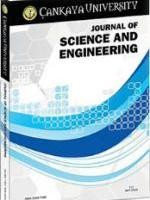Yamuk Kesitli Kanal İçerisinde Hidrodinamik Olarak Tam Gelişmiş Isıl Olarak Gelişmekte Olan Laminer Akış ve Isı Transferinin Sayısal Olarak İncelenmesi
Yamuk Kesitli Kanal İçerisinde Hidrodinamik Olarak Tam Gelişmiş Isıl Olarak Gelişmekte Olan Laminer Akış ve Isı Transferinin Sayısal Olarak İncelenmesi
Trapezoidal cross-section duct laminar forced convection, hydrodynamically fully developed thermally developing flow, Ansys Fluent 12.1.,
___
- [1] W. M. Kays and A. L. London, Compact Heat Exchangers, McGraw-Hill, New York, 1964.
- [2] S. M. Flockhart and R. S. Dhariwal, Experimental and numerical investigation into the flow characteristics of channels etched in silicon, Journal of Fluids Engineering 120 (1998), 291–295.
- [3] R. K. Shah, Laminar friction and forced convection heat transfer in ducts of arbitrary geometry, International Journal of Heat and Mass Transfer 18 (1975), 849–862.
- [4] A. Lawal and A. S. Mujumdar, Developing flow and heat transfer to power law fluids in square, trapezoidal and pentagonal ducts, International Communications in Heat and Mass Transfer 12 (1985), 23–31.
- [5] J. B. Aparecido and R. M. Cotta, Fully developed laminar flow in trapezoidal ducts, 9th Brazilian Congress of Mechanical Engineering, 1987 (IX COBEM) (1987), 25–28.
- [6] R. Sadasivam, R. M. Manglik and M. A. Jog, Fully developed forced convection through trapezoidal and hexagonal ducts, International Journal of Heat and Mass Transfer 42 (1999), 4321–4331.
- [7] J. Yuan, M. Rokni and B. Sund´en, Simulation of fully developed laminar heat and mass transfer in fuel cell ducts with different cross-sections, International Journal of Heat and Mass Transfer 44 (2001), 4047-4058.
- [8] R. K. Shah and A. L. London, Laminar Flow Forced Convection in Ducts, Academic Pres Inc., New York, 1978.
- [9] S. Kaka¸c, R. K. Shah and W. Aung, Handbook of Single-Phase Convective Heat Transfer, John Wiley and Sons, USA, 1987.
- [10] S. Kaka¸c and H. Liu, Heat Exchangers Selection, Rating, and Thermal Design, CRC Press, USA, 2002.
- [11] M. Renksizbulut and H. Niazmand, Laminar flow and heat transfer in the entrance region of trapezoidal channels with constant wall temperature, Journal of Heat Transfer 128 (2006), 63–74.
- [12] F. P. Incropera, D. P. DeWitt, T. L. Bergman and A. S. Lavine, Fundamentals of Heat and Mass Transfer, John Wiley & Sons, USA, 2007.
- Yayın Aralığı: Yılda 2 Sayı
- Başlangıç: 2009
- Yayıncı: Çankaya Üniversitesi
Serdar ÖZYÖN, Celal YAŞAR, Hasan TEMURTAŞ, Doğan AYDIN
m-Generators of Fuzzy Dynamical Systems
Mohammad EBRAHİMİ, Uosef MOHAMADİ
Nevzat Onur, Kamil ARSLAN, Oğuz Turgut
The Notion of Topological Entropy in Fuzzy Metric Spaces
Mehdi Karami, Mohammad Reza Molaei
Alaattin ESEN, Orkun TAŞBOZAN, N. Murat YAĞMURLU
First Record of Amerobelba decedens Berlese 1908 (Acari: Oribatida: Amerobelbidae) from Turkey
Optimum Cycle Time Prediction for Signalized Intersections at Baghdad City
